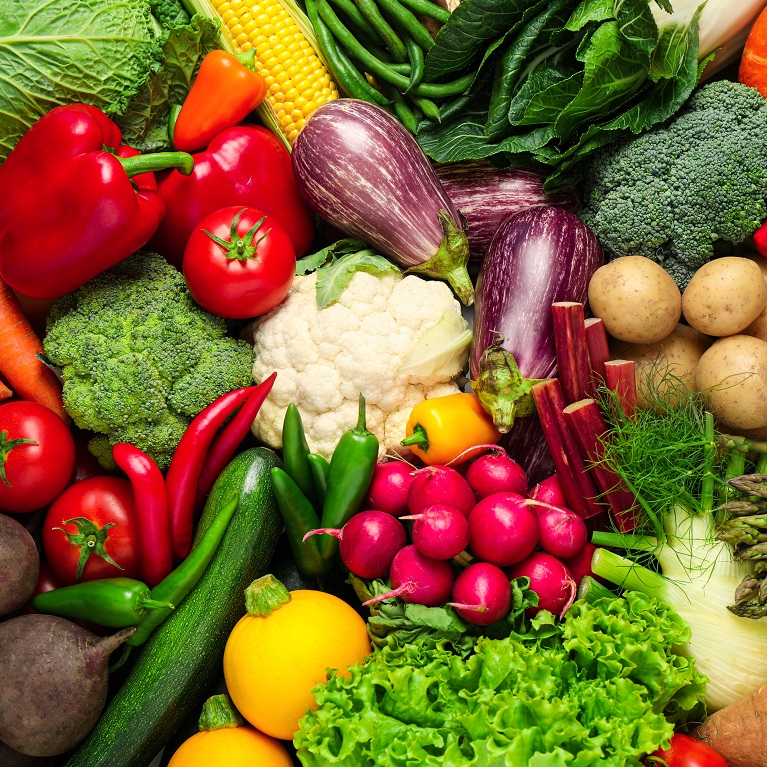Why do colors of food matter?
Color seems to make everything better, doesn’t it? A pop of color can brighten up a room, complete an outfit or make a meal more appealing – especially for kids.
While the benefits may seem simply visual, when it comes to your dinner plate, adding colorful vegetables and fruits does more than making it a feast for the eyes. The colors of fruits and vegetables come from their naturally occurring nutrients.
A diet rich in those plant nutrients has several health benefits, including providing antioxidants. Those plant nutrients are called phytonutrients and they have names like quercetin, proanthocyanidins and isothiocyanate, each of which provides support for different systems in our bodies.
But don’t worry, there is no need for you or your kids to remember all these complicated tongue twisters. All you have to do is think about all the colors of the rainbow. That’s because each color provides different health benefits. To ensure you’re getting a variety of nutrients, make sure you’re consuming a variety of colors.
Red foods: Colors and their benefits (red peppers, tomatoes, cherries)
What does red food do for you? The nutrients that give red fruits and vegetables their rich red color support your heart health and eye health and protect against cell-damaging free radicals.
How do you get them? Look for red foods when you are in the produce section: red peppers, tomatoes, radishes, apples and cherries. Or, if it’s the right season where you live, take your family cherry picking.
Showing your kids exactly where their food comes from and involving them in the picking process will encourage them to—literally—enjoy the fruits of their labor.
Orange and yellow foods: Colors and their benefits (oranges, lemons, peaches)
Orange and yellow fruits and vegetables provide support for your immune system, eye health and skin health. An orange, for example, has more than 170 different plant nutrients providing a variety of health benefits. And let’s not forget that vitamin C content!
Fresh squeezed lemonade, fruit salad, smoothies and grilled peaches are all great ways of including this essential color in your diet.
Green foods: Colors and their benefits (spinach, broccoli, avocado)
A diet rich in dark leafy greens provides a host of benefits, including many that support your heart health.
Green vegetables and fruits are also rich in fiber, vitamins A, C, E and K. And the plant nutrients that give them their green color support artery function and cell, lung and vision health.
Kale or spinach salads, sauteed veggies, green smoothies or avocado toast are all good ways of getting some of these into your body. If your kids are not into green food, try explaining all the great ways green foods build up their bodies or find ways to sneak them in without their knowledge, like adding finely chopped greens to sauces or smoothies.
Purple and blue foods: Colors and their benefits (plums, blueberries, purple kale)
Purple- and blue-hued fruits help support brain and heart health. Plus, they contain a large quantity of antioxidants, which provide several health benefits by helping your body fight free radicals.
It’s a color not many people get enough of, so do your best to search it out in the produce section. Carrots, cabbage, kale, cauliflower and sweet potatoes all have purple varieties when it comes to veggies.
And blueberry and blackberry seasons offer more reasons to get the family out for a group activity. They also are a great addition to any smoothie.
White foods: Colors and their benefits (bananas, potato, cauliflower)
The brighter colors of the rainbow tend to get all the publicity, but the variety of produce that falls into the pale or white category is pretty expansive: Bananas (after you peel them), cauliflower, garlic, mushrooms, onions, parsnips, potatoes, shallots, turnips, white corn, white peaches and more.
All those white fruits and vegetables provide benefits for your bones and help support your circulatory health and artery function.
Whether it’s pretending you are a monkey with a banana, or playing hot potato with your baked potatoes, there are plenty of ways to make eating these colors fun!
A rainbow of benefits with colorful fruits and vegetables
A good diet is a varied diet—meaning we should strive to feed our families fruits and vegetables from all the color groups on a regular basis. The colors come in all different shapes, sizes and tastes, so don’t be afraid to try new things with your family.
But nobody is perfect, especially where kids and vitamins are concerned. That’s when you might want to consider supplements to help fill any nutritional gaps. Nutrilite™ makes colorful, plant-based supplements for the whole family using plants grown on our own farms and partner farms.
The Nutrilite Organics Kids Complete Superfood Powder is a superfood chocolate shake mix that makes a great addition to your kid’s meal. It provides 8g of plant-based protein, 26 vitamins and minerals and 10 plant ingredients, including spinach leaves, blueberries, carrots, bananas and more.
You could also try the Nutrilite Kids Multivitamin Gummy, which has 12 vitamins and minerals along with plant nutrients from all five color groups. And it’s in a format kids will enjoy taking! When all the nutrients your kids need are in these fun-colored alternatives, you won’t have to worry about whether or not you win every single food battle.
Adults can benefit from supplements to help fill the color gaps, too, because we know they don’t always make the right food choices, either! Nutrilite Double X™ has 22 nutrients from colorful vegetables, herbs and fruits while Nutrilite Concentrated Fruits and Vegetables has the phytonutrient equivalent of five servings of fruits and vegetables with 13 plant-rich nutrients.
Feel good knowing there’s an option for you and your family when it comes to helping get your daily intake of vitamins, minerals and plant nutrients. Need some ideas on incorporating more fruits and vegetables into your weekly menu? Check out this article on plant-based diets

